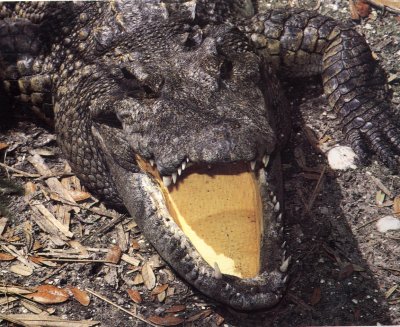The Siamese Crocodile

Crocodylus siamensis
Appearance
Size
Distribution
Habitat
Diet
Hunting
Reproduction
Dangers from Man
This medium sized croc is often mistaken for it's larger relative the estuarine crocodile by locals and is thus wrongfully blamed for attacks by this crocodile
Juveniles look quite a lot like salties in coloration with golden to tan body coloration with black stripes heading down the tail.

One sure fire way to tell these two apart is to look at their snouts. Crocodylus siamensis has a much wider snout than Crocodylus porosus and it's throat scales spread across the neck more as well. C.siamensis will also lack the obliquely placed bony ridges found extending from the eyes to the middle of the snout in C.porosus.
Crocodylus siamensis can grow to lengths of 4 meters, making for a hefty, yet not gargantuan, crocodile.
These crocodiles can be found in the tropical lowlands of mainland Southeast Asia (Thailand, Laos, Kampuchea, Vietnam and Malaya) along with some of the Indonesian islands.
These crocs frequent freshwater lakes, rivers and marshlands. They don't seem to inhabit brackish water, a preference that helps distinguish them from their larger counterparts.
A known piscivore, these broad snouted crocodiles also add snakes, frogs, insects and small mammals to their diet. The large size attained by adults can allow them to take down medium sized mammals as well, but mammals in the range of water buffalo (Bubalis bubalis) would be out of their reach.
These crocs will patrol rivers and lakes chasing fish and unlucky water fowl in the water. Terrestrial animals would be taken by the waters edge although youngsters are agile enough to chase smaller creatures on land.
Little is known about reproduction in the wild of these crocodiles. They are highly endangered and are extinct in the wilds of at least one country. As with other crocs territorial bouts between males probably take place along with calling from males to females.
After mating females will build mounds for their eggs and lay between 25-45 eggs where she will watch over them until and then after they hatch.
It is unknown whether or not the male participates in raising the young.
Youngsters will stick together during the first year or two of life before either going off on their own or joining the other adult crocodiles in the waterways.
While at 4 meters these crocs could represent a big threat to man, they rarely do and are often slaughtered by people who mistake them for the larger and more dangerous estuarine crocodiles who share the same waterways with them.
These crocodiles have been so overhunted, by both vengeful people and entrepreneurs, that they are considered one of the most highly endangered crocodiles and are already extinct in much of their range. Thusly it is ironic to occasionally see a specimen of these Appendix I species making it into the pet trade. These crocs don't make the most well behaved of pets and should not be kept as such. At least not until their numbers can be sufficiently replenished in the wild. Unfortunately with bad PR in it's native countries none of the locals want to see the return of these magnificent animals. The longer we wait the harder it will be to return these animals to an environment that was once theirs.
Something to think about.
Back to Crocodylids
Home


